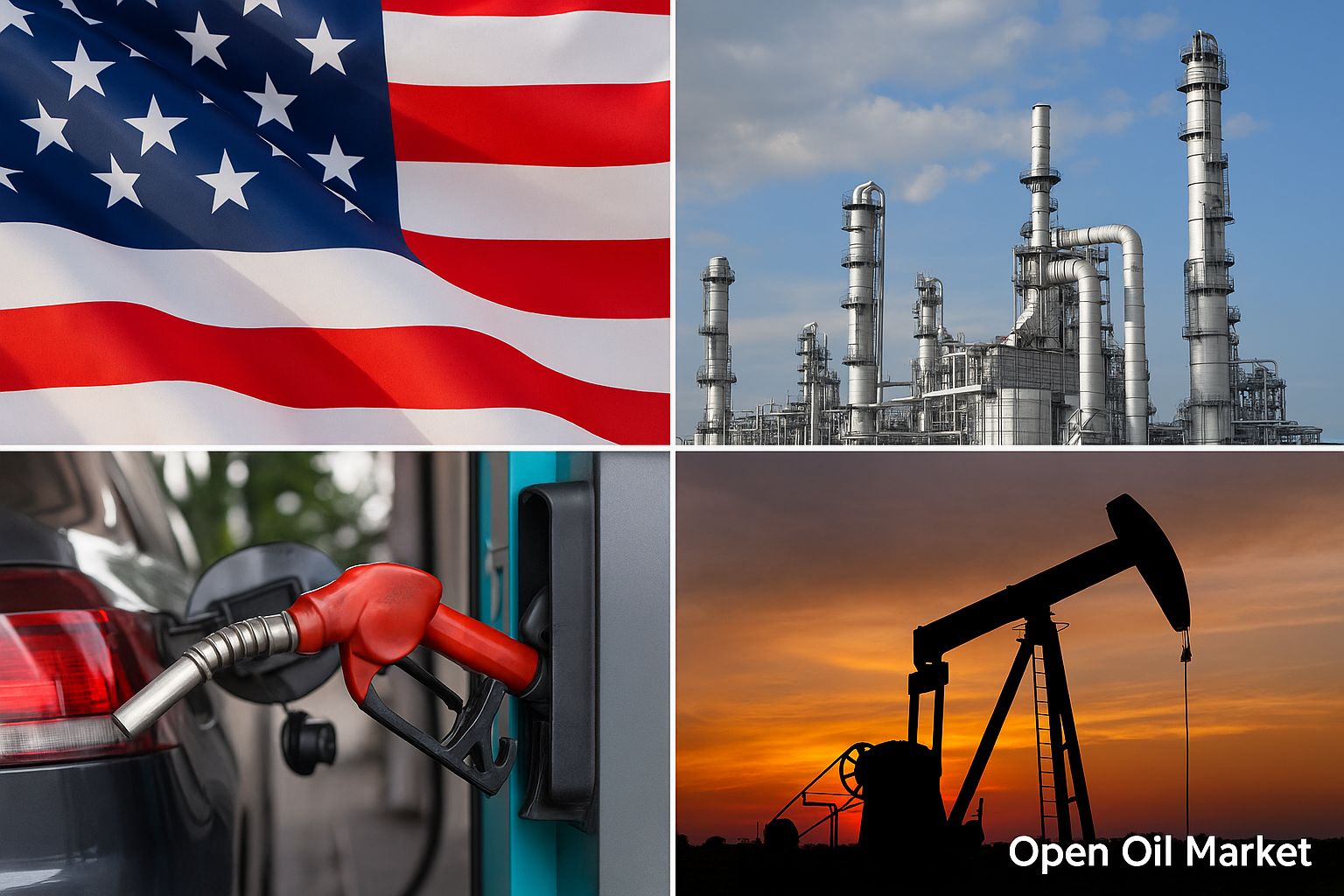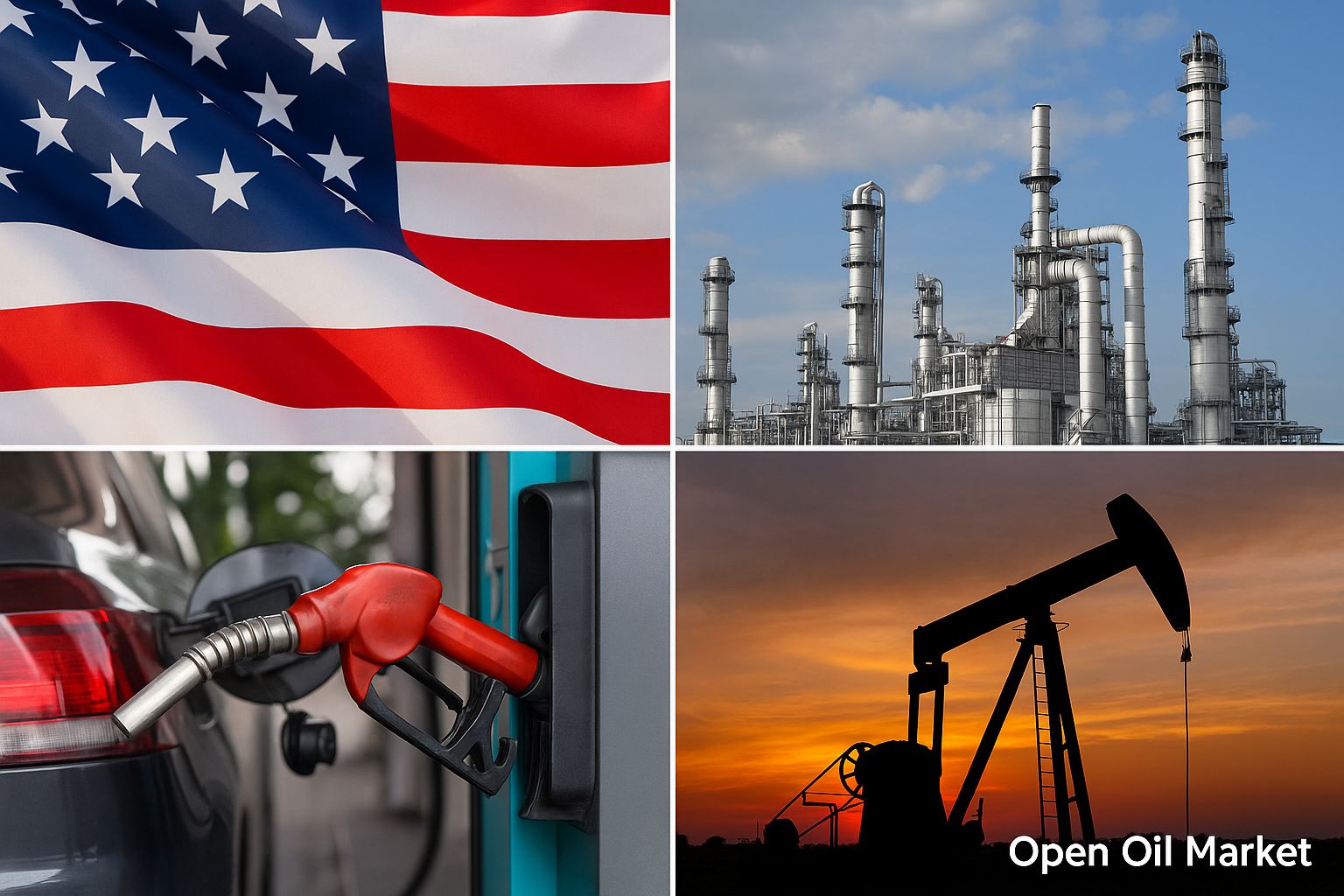
Detailed Review of the Energy Sector News as of August 15, 2025: Russia and US Negotiations in Alaska, Sanction Pressures, Brent Oil Price Forecasts, Gas Market Situation, Extension of Gasoline Export Ban, and Measures to Stabilize Fuel Prices in Russia.
In mid-August, the global fuel and energy complex is demonstrating mixed trends. The oil market faces pressure due to rising supply and slowing demand, increasing the risks of further price declines. At the same time, geopolitical intrigue comes to the forefront: the crucial summit between Russia and the US in Alaska may impact energy cooperation despite threats of new sanctions. The gas market remains relatively calm: European storage facilities are approaching full capacity, and prices remain stable. Renewable energy continues to gain share, setting new records for electricity generation worldwide. In Russia, authorities have extended the ban on gasoline exports, aiming to curb domestic fuel prices amid peak summer demand. Below is a detailed overview of key events and trends in the oil, gas, power generation, and other sectors of the energy complex as of August 15, 2025.
Oil Market: Brent Under Pressure Amid Supply Surplus and Slowing Demand
Oil prices have shown moderate growth after a decline the previous day. The North Sea Brent blend hovers around $66 per barrel, while American WTI trades at approximately $63. Despite short-term fluctuations, current prices remain about 10–15% lower than a year ago, reflecting market correction following the peak energy crisis of 2022–2023. The price of oil is currently influenced by several factors:
- OPEC+ Production Increase. The oil alliance continues to increase supply: in August, the production ceiling for key participants was raised by 548 thousand barrels per day, with a similar move expected in September. In April–July 2025, quotas were systematically increased, leading to a rise in commercial oil and petroleum product reserves globally.
- Slowing Demand Growth. The International Energy Agency (IEA) has lowered its forecast for global oil demand growth in 2025 to approximately 685 thousand barrels per day (down from ~704 thousand previously). Even OPEC, traditionally more optimistic, estimates demand growth for 2025 at only ~1.3 million barrels per day compared to 2.6 million in 2023. Consumption rates are clearly declining, raising risks of market oversupply.
- Geopolitical Uncertainty. The US-Russia negotiations pose both risks and opportunities for the market. On one hand, Washington has threatened stringent measures (up to 100% tariffs on Russian oil and secondary sanctions) in case of failed peace agreements—these threats add a "risk premium" to the oil market. On the other hand, the very fact of dialogue between leaders instills hopes for gradual lifting of certain restrictions in the oil and gas sector in the future.
As a result of these factors, the oil market trends towards surplus, keeping prices under pressure.
"The average price of Brent oil may drop below $50 per barrel in the first half of 2026 due to increased production by OPEC+ countries and slowing global demand growth," predicts Sergey Tereshkin (column in RBC).
Gas Market: High Stocks in Europe and Stable Prices
The focus in the gas market remains on Europe. EU countries are rapidly filling natural gas in underground storage, preparing for the winter period. By mid-August, European UGS facilities are over 80% filled in total capacity, confidently approaching the target level of 90% set for early November. Exchange prices for gas remain at moderate levels: September futures at the TTF hub trade around €32/MWh (about $400 per thousand cubic meters), reflecting a balance between supply and demand.
European importers continue to actively purchase liquefied natural gas (LNG). In July 2025, LNG imports to Europe reached 11.3 billion cubic meters, a 37% increase compared to the previous year—additional LNG supplies speed up the filling of storage facilities. Meanwhile, across the Atlantic, gas prices remain significantly lower: in the US, prices hover around $2.8 per million BTUs (approximately $100 per thousand cubic meters) due to record production and market saturation. Overall, high stock levels and stable gas inflows (pipeline and LNG) sustain relative calm in the global gas market.
International Politics: The Alaska Summit and Sanction Prospects
On August 15, during a visit to Alaska, a meeting between the presidents of Russia and the US will take place. It is expected that the main topic of negotiations between Vladimir Putin and Donald Trump will be the resolution of the conflict in Ukraine, so concrete deals on oil and gas projects are not anticipated as a result of the summit. Nevertheless, the final agreements could set the framework for the resumption of energy cooperation between the two countries.
"The meeting in Alaska is unlikely to end with agreements on specific projects in the oil and gas sector, as the main topic of negotiations will not be oil and gas at all. However, the meeting could establish new frameworks for bilateral cooperation—such as lifting the ban on energy resource imports from Russia and allowing American companies to return to the Russian market," stated Sergey Tereshkin (RIA News commentary).
According to the expert, a positive scenario involves lifting the existing US ban on imports of Russian oil and gas, as well as the return of American oil and gas companies to Russia. Their return is particularly important for the implementation of Arctic and offshore projects, where the domestic industry requires Western technologies and equipment. At the same time, the lack of progress in negotiations threatens to intensify sanction pressures from Washington. The US administration has indicated that it is prepared to impose new restrictive measures if the summit does not yield results. Thus, the outcome of the meeting in Alaska will have significant implications for energy cooperation and sanction policies.
Ukraine: Rising Dependence on Energy Imports
Against the backdrop of the protracted conflict, Ukraine is facing a shortage of its own energy resources and is forced to increase purchases from abroad. In 2024, the country consumed about 19.9 billion cubic meters of gas while producing around 18.1 billion cubic meters—a gap traditionally covered by imports. After the cessation of direct transit of Russian gas since 2025, Kyiv physically receives fuel from Europe (essentially, the same Russian gas resold by European suppliers). In 2025, the need for imports surged; for example, in July, Ukraine increased gas purchases 1.5 times compared to June (to ~0.833 billion cubic meters), replenishing depleted storage ahead of winter. By early August, gas reserves in Ukrainian storage facilities were at only about 32% capacity (~10 billion cubic meters)—the lowest level in 12 years. To smoothly pass through the heating season, the Ukrainian Ministry of Energy estimates that it is necessary to accumulate 13.2 billion cubic meters by November 1, meaning Ukraine will need to import about 1.7 billion cubic meters of gas from August to October.
The electricity sector is equally acute—significant portions of generating capacity are out of service, prompting the country to actively import electricity from EU countries. Key neighbors such as Hungary, Slovakia, Poland, and Romania play an essential role, accounting for the bulk of the flows. With thermal generation losses exceeding half, Ukrainian nuclear power plants currently generate around 70% of the country’s electricity, with the shortfall covered by imports.
"Electricity imports to Ukraine increased by more than 40% in the first five months of 2025—from 1.15 billion kWh (January–May 2024) to 1.65 billion kWh (January–May 2025). Hungary, Poland, Slovakia, and Romania are among the main suppliers. The increase in imports is associated with thermal generation losses, resulting in around 70% of electricity generation being provided by nuclear power plants," noted Sergey Tereshkin (for the newspaper "Vzglyad").
Thus, Ukraine's energy security heavily relies on supplies from neighboring countries. Imported energy resources allow the country to meet domestic demands; however, they come with high costs and risks. In the summer months, Ukraine's import expenditures for electricity significantly exceed revenues from export supplies, creating additional pressure on the economy. Maintaining stability in energy supply would be extremely difficult without external support.
Power Generation and Renewables: Record Consumption and Growth of Green Generation
The abnormal heat this summer has set new records for electricity consumption across various regions of the world. In China, energy system loads reached historic peaks of around 1.5 TW of peak capacity in July due to extreme heat and widespread use of air conditioning. However, a significant portion of the increased demand was covered by solar power generation and increased hydroelectric generation compared to last year.
In the US, the share of electricity generated from renewable sources has exceeded 30% for the first time—this is a record high. Wind and solar generation have together outpaced coal plants for the first time, pushing coal to a secondary role. In Europe, the situation has also normalized following the energy crisis of 2022-2023: gas storage is full, new wind farms and solar plants are operational, and coal's share in the EU's energy balance is again decreasing.
Analysts predict that by 2026, renewable sources may surpass coal in global electricity generation. The expansion of renewable capacities—from giant solar parks to offshore wind farms—combined with the gradual reduction of output from aging coal-fired power plants will lead to "green" energy taking the lead. These trends underscore the growing role of renewables in meeting demand. Even under extreme conditions, energy systems demonstrate resilience, largely thanks to record volumes of generation based on renewable technologies.
Coal Sector: High Demand Amid Stable Prices
Despite the successes of "green" energy, the coal industry remains crucial—especially in the Asian region. Demand for coal remains high to meet rising electricity needs in developing economies. The largest consumer of coal, China, is forecasted to maintain fuel burning close to record levels to ensure its energy system's reliability. India and several other Asian countries are also relying on coal to address increased energy consumption. Meanwhile, global coal production and exports have adapted to growing demand: prices for thermal coal have remained relatively stable in recent months, indicating a balance in supply. Thus, coal continues to represent a significant share in the global energy balance and will remain an important component of energy supply in the coming years, even as some countries accelerate their energy transition.
Russian Oil Products Market: Measures to Stabilize Fuel Prices
In the domestic market of Russia, the situation with fuel remains a focus for the government. In early August, wholesale gasoline prices continued to rise against high summer demand and limited supply, prompting authorities to extend and strengthen market regulation. On August 14, Deputy Prime Minister Alexander Novak held a meeting on the situation in the domestic petroleum products market, resulting in a series of measures to normalize the situation:
- The ban on gasoline exports has been extended until the end of September and will apply to all fuel producers.
- In October, partial lifting of restrictions is planned: the embargo will remain only for traders, oil depots, and small refineries, while large oil companies may be allowed to resume exports.
- Accidents at several major oil refineries have led to a reduction in gasoline production and a spike in prices. Repair of damaged facilities may take from one month to six months, limiting the possibilities for quickly increasing fuel supply.
- Novak urged oil companies to maintain sufficient sales volumes in the domestic market and to refrain from purchasing fuel from each other on the exchange since such trades have driven up prices. Previously, during the peak fuel crisis of 2023, the government already prohibited targeted exchange transactions between companies. The Federal Antimonopoly Service, the Ministry of Energy, and the St. Petersburg Exchange are now working on long-term measures that encourage direct contracts between producers and fuel suppliers instead of speculative trading.
This set of steps aims to stabilize prices and saturate the domestic market for petroleum products. The extension of export restrictions and control over exchange trading should prevent fuel shortages and contain the rise in gasoline prices for end consumers amid peak demand. The government intends to ensure that gas stations in the regions are fully supplied with fuel and that the situation of the previous year, marked by a sharp price spike, does not repeat.




